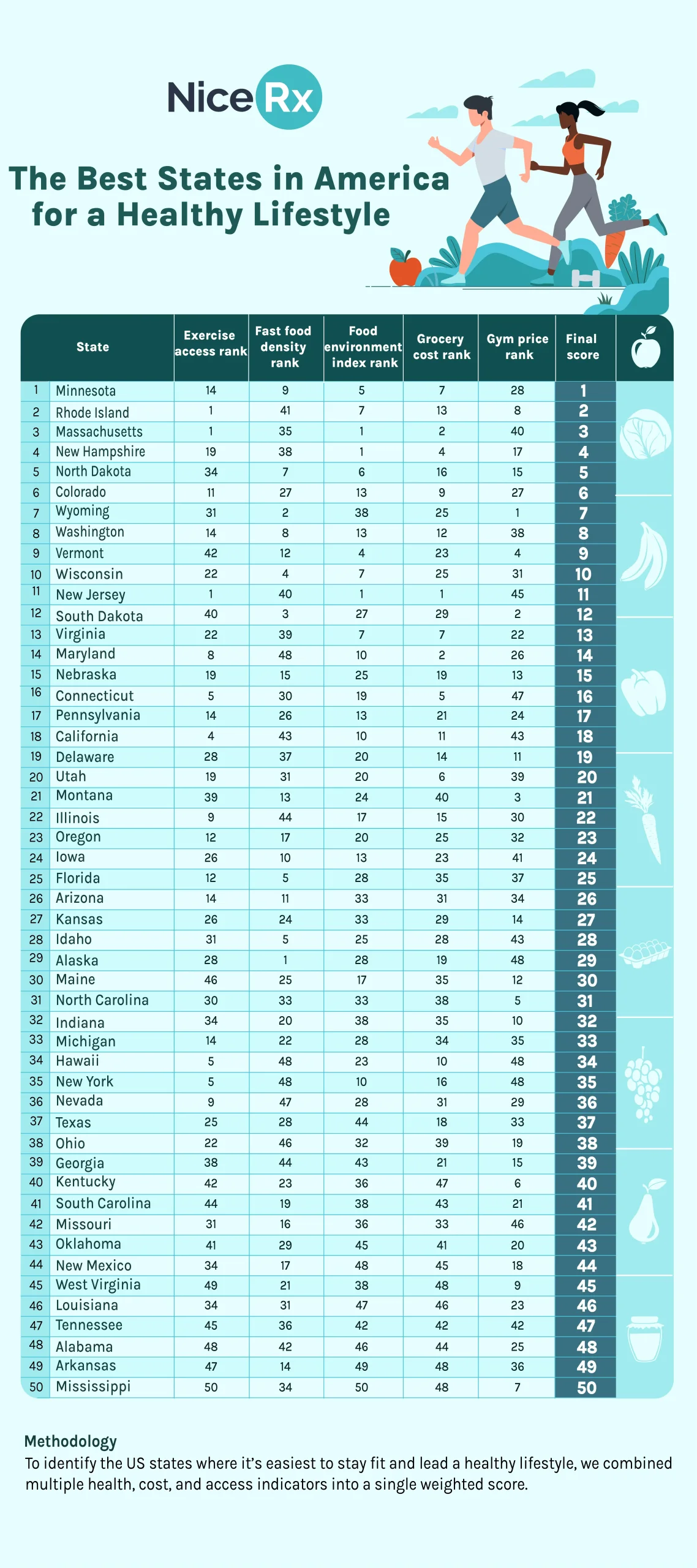The Best States in America for a Healthy Lifestyle
Trying to stay fit or lose weight is never just about willpower. The environment around you can either help you succeed or make every step harder. From the price of groceries to how easy it is to find a gym, where you live has a big impact on how realistic it feels to build healthier habits.
That’s exactly why we looked at the data to rank the states where staying fit and losing weight is easiest, and where it’s most difficult. For NiceRx, making weight loss treatment more accessible is part of the mission – helping people remove unnecessary barriers on the path to better health.
Here are the states that give you the best shot at success, and the ones where the odds are stacked against you:
Key Findings
- Minnesota ranks first for staying fit.
- Rhode Island and Massachusetts place second and third.
- Mississippi ranks last overall.
- Arkansas, Alabama, and South Carolina are also among the lowest.

The 10 Best States to Stay Fit
- Minnesota
Minnesota takes the crown thanks to a mix of affordable groceries, plenty of exercise options, and a culture that values movement in all seasons. Residents make the most of summer trails, lakes, and bike paths, then embrace skating and skiing when winter arrives. Fitness here feels less like a chore and more like a natural part of daily life. Communities are set up to make healthy choices easier, which gives Minnesota a lasting advantage. - Rhode Island
This small state shows that size does not dictate health. Rhode Island stands out with strong exercise access, affordable gyms, and a food environment that makes nutritious choices more reachable. The oceanfront adds opportunities for outdoor activity, from sailing to jogging along the shore. Even with limited land, the state offers a broad set of tools for residents to stay active. - Massachusetts
Massachusetts balances good grocery costs with strong access to fitness opportunities. Cities like Boston encourage walking and biking, while the state’s forests and coasts give residents a break from urban routines. Health-focused communities and access to gyms mean people have multiple options to stay on track. Education levels also play a role, as residents tend to be more aware of nutrition and exercise benefits. - New Hampshire
New Hampshire’s mountains and lakes double as a fitness playground, but its strengths are not limited to nature. Low grocery costs and solid gym access give people flexibility in how they approach health. Rural residents often rely on outdoor recreation, while city dwellers lean on gyms and fitness centers. The combination keeps the state competitive among the healthiest in the country. - North Dakota
North Dakota’s wide-open spaces help encourage outdoor living, but affordability is what pushes it into the top five. Groceries are cheaper here than in many states, and gyms cost less too. Families are better able to budget for healthier foods, and exercise becomes more accessible. Even without the dramatic landscapes of Colorado or Vermont, North Dakota offers steady support for those who want to stay fit. - Colorado
Colorado is practically built for fitness, with trails, peaks, and ski slopes inviting people outside year-round. Beyond nature, the state scores high on exercise opportunities in general, so urban residents also benefit. Food environment rankings show that access to healthy options is solid, though not the very best. Still, the culture here has long favored active living, which helps maintain Colorado’s reputation as one of the healthiest states. - Wyoming
Wyoming’s rugged scenery shapes how people stay active, whether that means hiking through Yellowstone or skiing in Jackson. Grocery prices are reasonable, and gyms are not out of reach for most households. Smaller communities may lack the variety of fitness centers you’d find in bigger states, but the outdoors fills that gap. The mix of affordability and environment makes Wyoming a strong performer. - Washington
Washington offers the best of both worlds, with city gyms and rural trails equally within reach. The Cascade Mountains and Puget Sound encourage outdoor recreation, while cities like Seattle provide infrastructure for cycling, walking, and gym training. Grocery costs are fair, and the food environment helps support healthier eating. Rain is frequent, but residents adapt by making fitness part of daily life indoors and out. - Vermont
Vermont’s wellness-friendly culture pushes it into the top ten. Residents enjoy fresh air, plenty of outdoor recreation, and strong community support for healthy living. The state does well in exercise access and healthy food options, and gyms are accessible despite Vermont’s small size. Local traditions like farmers’ markets and small-town community sports contribute to its ranking. Vermont proves that wellness thrives when it is rooted in culture as much as in infrastructure. - Wisconsin
Wisconsin closes out the top ten with a mix of affordability and access. Grocery prices are better than average, and gyms are within reach for many households. Outdoor recreation revolves around lakes and forests, giving people seasonal variety in their activities. While the state is known for indulgent foods, its infrastructure for fitness helps balance those cultural habits. Wisconsin shows that health and tradition can coexist.
The 10 Worst States to Stay Fit
- Mississippi
Mississippi sits at the bottom of the rankings with some of the weakest access to gyms and healthy foods. Grocery prices are higher than many states, and fast food remains the more convenient option for many families. These structural challenges add up, making it harder for residents to build and maintain healthier routines. Without significant improvements in access and affordability, Mississippi faces an uphill battle. - Arkansas
Arkansas ranks poorly across multiple measures. Fitness centers are limited, and food costs make healthier options harder to sustain. Fast food outlets are common, which makes unhealthy eating more tempting. For people in rural areas, long distances to gyms and grocery stores make the challenge even greater. Arkansas illustrates how access can shape outcomes more than personal motivation. - Alabama
Alabama struggles with limited exercise options and a high concentration of fast food restaurants. Grocery affordability is weaker, and gyms are not always easy to find at reasonable prices. Outdoor resources exist, but they are not supported by the same level of infrastructure seen in healthier states. Residents often face systemic barriers that make staying fit more difficult. - Tennessee
Tennessee mirrors Alabama in many ways. Access to gyms is limited, and fast food is widespread. Grocery and food environment scores are also low, which undercuts the state’s ability to support long-term wellness. Urban centers like Nashville and Memphis provide more resources, but the rural majority is left with fewer opportunities. This divide keeps Tennessee near the bottom. - Louisiana
Louisiana’s culinary heritage is world-famous, but it is also heavy on calories. That challenge is compounded by higher grocery costs and limited gym affordability. The state’s food environment does little to offset the trend, leaving healthier options less accessible. Outdoor recreation is available, but systemic barriers mean it does not close the gap. Residents often need extra effort to maintain fitness in this environment. - West Virginia
West Virginia ranks low because of poor gym access, limited healthy food availability, and higher exercise costs. Rural areas face particular challenges, as grocery stores with fresh produce are less common. The mountains provide natural activity options, but affordability and infrastructure issues block wider participation. These conditions reinforce West Virginia’s placement near the bottom of the list. - New Mexico
New Mexico’s open landscapes provide room for activity, but affordability metrics tell a different story. Grocery costs are relatively high, and gyms are not among the cheapest either. The food environment ranks low, which makes healthy eating harder to maintain. The gap between natural opportunity and actual support structures keeps New Mexico down in the rankings. - Oklahoma
Oklahoma struggles with one of the highest fast food densities in the nation. Gym prices are above average, which limits structured fitness options. The food environment does not consistently support healthier diets, and rural infrastructure gaps make matters worse. Despite wide-open spaces, the systems in place make it harder for residents to prioritize fitness. - Missouri
Missouri lands near the bottom due to overlapping challenges in diet and fitness access. The state’s food environment ranks poorly, with healthy options harder to come by. Gym access is weaker than average, and fast food remains common throughout the state. These factors add up to a setting where health is harder to sustain compared to higher-ranked states. - South Carolina
South Carolina rounds out the bottom ten. The state faces challenges with both grocery affordability and gym access, limiting residents’ ability to build healthier routines. Fast food density remains high, adding to the difficulty of maintaining nutritious diets. Outdoor resources like beaches and trails exist but are not enough to outweigh systemic weaknesses. This combination places South Carolina among the toughest states for staying fit.
Closing Thoughts
Living a healthy life depends not just on willpower, but on the environment that surrounds you. Minnesota and Colorado show how a mix of affordability, infrastructure, and culture can work together to support wellness. Mississippi, Arkansas, and Alabama reveal how limited access and higher costs create daily obstacles for residents.
Fitness may start with personal decisions, but the state you live in plays a powerful role in shaping the outcome.
Methodology
To identify the US states where it’s easiest to stay fit and lead a healthy lifestyle, we combined multiple health, cost, and access indicators into a single weighted score.
1. Data Collection
We gathered state-level data from trusted public and industry sources:
- Food Environment Index – County Health Rankings
- Access to Exercise Opportunities – County Health Rankings
- Total Number of Fast Food Restaurants per 100,000 People – NiceRx Fast Food Capitals study
- 2025 Average Gym Membership Price (USD/month) – 24/7 Wall St
- Cost of Groceries as a Share of Median Monthly Household Income – WalletHub
2. Normalization
- Each metric was scaled to a 0–100 range to allow for cross-comparison.
- For positive indicators (Food Environment Index, Access to Exercise), higher raw values were normalized to higher scores.
- For negative indicators (Fast Food Density, Gym Price, Grocery Share), higher raw values were inverted so that higher normalized scores represented more favorable conditions.
3. Weighting
- All five factors were weighted equally, each contributing 20% of the final score.
4. Final Scoring
- A composite Final Score was calculated as the average of all weighted metrics.
- States were ranked from highest to lowest final score. A higher score represents a state more favorable for a healthy lifestyle, and maintaining or improving fitness based on affordability, access, and environment.
